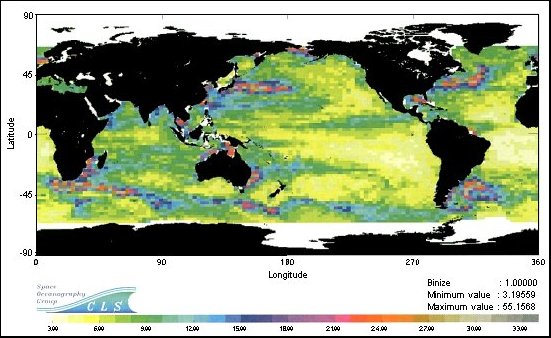Validation results
P.Y. Le Traon, J. Stum (CLS, France), P. Vincent (CNES, France)
Latest Cnes results of calibration at Lampedusa and Harvest
The Cnes calibration team has continued assessing performance of the Nasa ALT altimeter and Cnes SSALT with enhanced in situ and altimeter processing to derive the absolute biases [Ménard et al, 1994]. In six passes over Lampedusa and Harvest, the mean SSALT bias was estimated at +1 cm with an uncertainty of 2.4 cm. A bias was also estimated for the ALT altimeter from just two passes over Lampedusa.
The resulting figures are to be treated cautiously: a -18.5 cm bias for ALT with an uncertainty of 3.4 cm. Global repeat-track analysis of the Topex/Poseidon data (see below) reveals a relative bias between the two altimeters of around 15.5 cm. Using this value and the absolute SSALT bias measured at Lampedusa, absolute bias for ALT is estimated to be 14.5 cm, remarkably close to the value the JPL team obtained at Harvest.
Global analysis of Topex/Poseidon data and validation
Now that we have more than a year of Topex/Poseidon data to analyze, we can report fully on validation. Working on Aviso, the CLS space oceanography group did global statistical analyses on the Topex and Poseidon data and routinely validated the data distributed [Le Traon et al., 1994]. Processing consisted mainly of:
- analyzing differences at crossover points,
- repeat-track analysis,
- comparisons between the different geophysical corrections, such as TMR versus ECMWF wet tropospheric correction, and dual frequency versus Doris ionospheric correction.
The differences at crossover points show a global standard deviation of 10 to 12 cm with respect to the Cartwright and Ray tide model [1990]. This reduces to 8-9 cm with the new tide models based on Topex/Poseidon data [Ma et al., 1994]. Topex and Poseidon provide remarkably similarly results. Thus the T-T, T-P and P-P differences over the first 30 cycles are 10.05 cm, 10.15 cm and 10.15 cm respectively. These results are obtained using the Gaspar et al. [1994] electromagnetic bias corrections.
They show the excellent compatibility of the Topex and Poseidon altimeters. The relative bias between Topex and Poseidon is around 15.5 cm ± 1 cm (Topex ranging is under-estimated).
The bias is determined by analyzing the differences between the Poseidon cycles (20, 31, 41, 55 and 65) and the adjacent Topex cycles, with the Gaspar et al. [1994] electromagnetic bias corrections. Poseidon electromagnetic bias is stronger than Topex. The new parametrizations by Gaspar et al. [1994] can be used to correct for these effects for both Topex and Poseidon. We recommend them.
Standard deviation of sea-level variability (cm) from analysis of first 55 Topex/Poseidon cycles.
Repeat-track analysis confirms the high quality of Topex/Poseidon measurements. The figure shows the standard deviation of sea level variability from the first 55 cycles, using a new tide model based on Topex/Poseidon data [Ma et al., 1994]. In areas of weak ocean variability, the standard deviation is just 4 cm. These results and crossover point analysis show orbital error to be less than 5 cm and probably around 3 cm rms, in agreement with estimates by the orbitography teams [e.g. Nouel et al., 1994].
Stum [1994] systematically compared the wet tropospheric corrections given by the TMR radiometer with those calculated from the ECMWF model outputs. TMR is better for mapping intermediate tropospheric correction scales (100 to 1000 km).
The standard deviation of the difference between the corrections is 3 cm, ECMWF tending to overestimate moisture in very wet regions. Overall, the ECMWF correction is rather good quality and could be used if TMR failed.Le Traon et al. [1994b] compared the ionospheric correction deduced from the Topex dual frequency altimeter with that deduced from Doris over one year from cycle 2 to 36. The standard deviation of the difference within a cycle varies from 0.5 to 2 cm. There are differences at periods of 60 days (6 cycles), related to differences in local time (apparent period 60 days) and long-period effects due to decreases in solar activity. Thus, from cycle 30, Doris and the dual-frequency correction always agree to within 1 cm rms. The maximum differences are all along the geomagnetic equator where they can exceed 5 cm during periods of maximum ionospheric correction. These values could be reduced by improved Doris coverage. The errors in the Doris ionospheric correction remain, however, weak enough relative to the ocean signal.
References :
- Cartwright, D.E., and R.D. Ray, 1990, Oceanic tides from Geosat altimetry, J. Geophys. Res., 95, 3069-3090.
- Gaspar, P., Ogor, F., P.Y. Le Traon, and O.Z. Zanife, 1994. Joint estimation of the TOPEX and POSEIDON sea-state biases, J. Geophys. Res. (in press).
- Le Traon, P. Y., J. Stum, J. Dorandeu, and P. Gaspar, 1994a. Global statistical analysis of TOPEX and POSEIDON data, J. Geophys. Res. (in press).
- Le Traon, P. Y., J. Dorandeu, F. Ogor and P. Sicard 1994b. Comparison des corrections ionosphériques calculées à partir de DORIS et de l'altimètre bifréquence TOPEX. CNES-CLS contract report GO/93/203.
- Ma, X. C., C. K. Shum, R.J. Eanes, and B.D. Tapley, 1994. Determination of ocean tides from the first year of TOPEX/POSEIDON altimeter measurements, J. Geophys. Res. (in press).
- Ménard, Y., E. Jeansou and P. Vincent, 1994, Calibration of the TOPEX/ POSEIDON altimeters at Lampedusa. Additional results at Harvest, J. Geophys. Res. (in press).
- Nouel, F., C. Valorge, P. Laudet, M. Deleuze, Guitart, A. Piuzzi, J.P. Berthias, and D. Taburiau, 1994. Precise CNES orbits for TOPEX/ POSEIDON: is reaching 2 cm still a challenge?, J. Geophys. Res. (in press).
- Stum, J., 1994. A comparison between TOPEX microwave radiometer, ERS-1 microwave radiometer and ECMWF derived wet tropospheric corrections, J. Geophys. Res. (in press).




